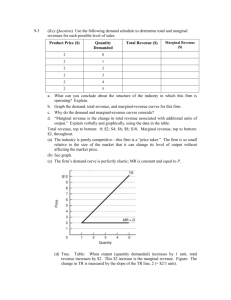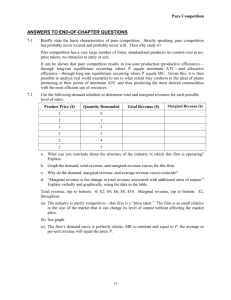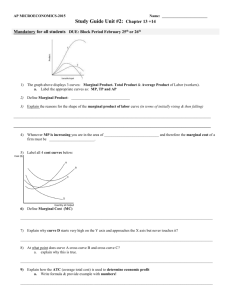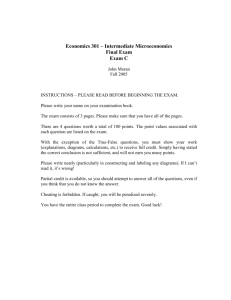answers to end-of-chapter questions
advertisement
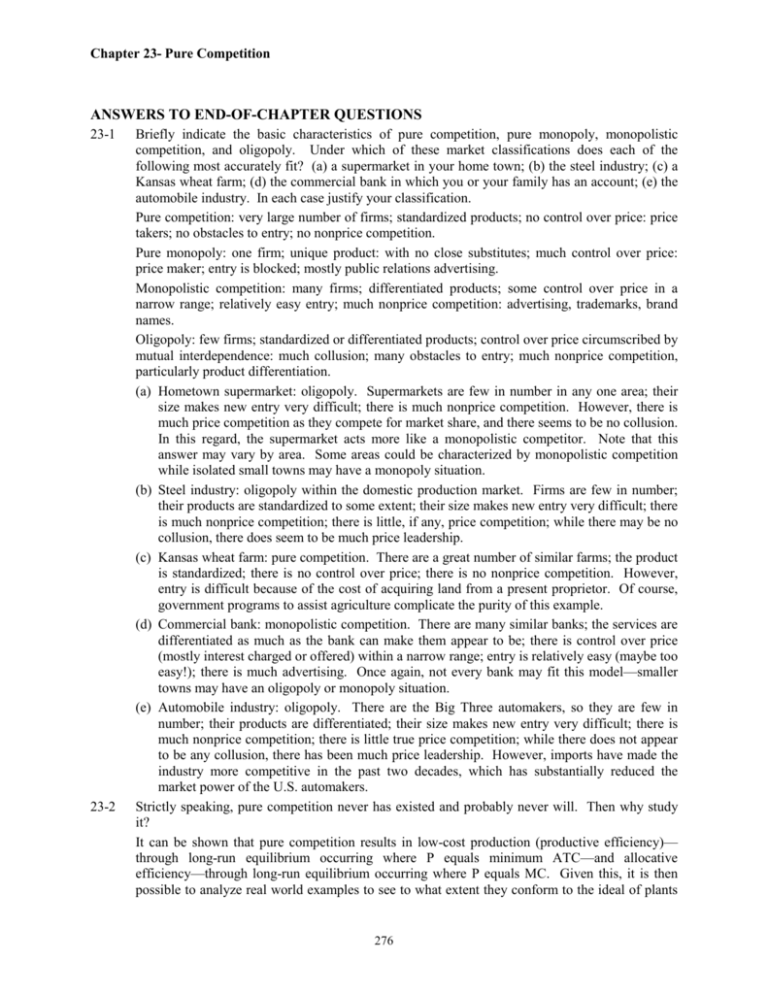
Chapter 23- Pure Competition ANSWERS TO END-OF-CHAPTER QUESTIONS 23-1 23-2 Briefly indicate the basic characteristics of pure competition, pure monopoly, monopolistic competition, and oligopoly. Under which of these market classifications does each of the following most accurately fit? (a) a supermarket in your home town; (b) the steel industry; (c) a Kansas wheat farm; (d) the commercial bank in which you or your family has an account; (e) the automobile industry. In each case justify your classification. Pure competition: very large number of firms; standardized products; no control over price: price takers; no obstacles to entry; no nonprice competition. Pure monopoly: one firm; unique product: with no close substitutes; much control over price: price maker; entry is blocked; mostly public relations advertising. Monopolistic competition: many firms; differentiated products; some control over price in a narrow range; relatively easy entry; much nonprice competition: advertising, trademarks, brand names. Oligopoly: few firms; standardized or differentiated products; control over price circumscribed by mutual interdependence: much collusion; many obstacles to entry; much nonprice competition, particularly product differentiation. (a) Hometown supermarket: oligopoly. Supermarkets are few in number in any one area; their size makes new entry very difficult; there is much nonprice competition. However, there is much price competition as they compete for market share, and there seems to be no collusion. In this regard, the supermarket acts more like a monopolistic competitor. Note that this answer may vary by area. Some areas could be characterized by monopolistic competition while isolated small towns may have a monopoly situation. (b) Steel industry: oligopoly within the domestic production market. Firms are few in number; their products are standardized to some extent; their size makes new entry very difficult; there is much nonprice competition; there is little, if any, price competition; while there may be no collusion, there does seem to be much price leadership. (c) Kansas wheat farm: pure competition. There are a great number of similar farms; the product is standardized; there is no control over price; there is no nonprice competition. However, entry is difficult because of the cost of acquiring land from a present proprietor. Of course, government programs to assist agriculture complicate the purity of this example. (d) Commercial bank: monopolistic competition. There are many similar banks; the services are differentiated as much as the bank can make them appear to be; there is control over price (mostly interest charged or offered) within a narrow range; entry is relatively easy (maybe too easy!); there is much advertising. Once again, not every bank may fit this model—smaller towns may have an oligopoly or monopoly situation. (e) Automobile industry: oligopoly. There are the Big Three automakers, so they are few in number; their products are differentiated; their size makes new entry very difficult; there is much nonprice competition; there is little true price competition; while there does not appear to be any collusion, there has been much price leadership. However, imports have made the industry more competitive in the past two decades, which has substantially reduced the market power of the U.S. automakers. Strictly speaking, pure competition never has existed and probably never will. Then why study it? It can be shown that pure competition results in low-cost production (productive efficiency)— through long-run equilibrium occurring where P equals minimum ATC—and allocative efficiency—through long-run equilibrium occurring where P equals MC. Given this, it is then possible to analyze real world examples to see to what extent they conform to the ideal of plants 276 Chapter 23- Pure Competition 23-3 producing at their points of minimum ATC and thus producing the most desired commodities with the greatest economy in the use of resources. (Key Question) Use the following demand schedule to determine total and marginal revenues for each possible level of sales: Product Price ($) Quantity Demanded 2 0 2 1 2 2 2 3 2 4 2 5 Total Revenue ($) Marginal Revenue ($) a. What can you conclude about the structure of the industry in which this firm is operating? Explain. b. Graph the demand, total-revenue, and marginal-revenue curves for this firm. c. Why do the demand and marginal-revenue curves coincide? d. “Marginal revenue is the change in total revenue.” Explain verbally and graphically, using the data in the table. Total revenue, top to bottom: 0; $2; $4; $6; $8; $10. Marginal revenue, top to bottom: $2, throughout. (a) The industry is purely competitive—this firm is a “price taker.” The firm is so small relative to the size of the market that it can change its level of output without affecting the market price. (b) See graph. (c) The firm’s demand curve is perfectly elastic; MR is constant and equal to P. (d) Yes. Table: When output (quantity demanded) increases by 1 unit, total revenue increases by $2. This $2 increase is the marginal revenue. Figure: The change in TR is measured by the slope of the TR line, 2 (= $2/1 unit). 277 Chapter 23- Pure Competition 23-4 (Key Question) Assume the following unit-cost data are for a purely competitive producer: Total Product Average fixed cost Average variable cost Average total cost 0 1 2 3 4 5 6 7 8 9 10 $60.00 30.00 20.00 15.00 12.00 10.00 8.57 7.50 6.67 6.00 $45.00 42.50 40.00 37.50 37.00 37.50 38.57 40.63 43.33 46.50 $105.00 72.50 60.00 52.50 49.00 47.50 47.14 48.13 50.00 52.50 Marginal cost $45 40 35 30 35 40 45 55 65 75 a. At a product price of $56, will this firm produce in the short run? Why, or why not? If it does produce, what will be the profit-maximizing or loss-minimizing output? Explain. What economic profit or loss will the firm realize per unit of output. b. Answer the questions of 4a assuming that product price is $41. c. Answer the questions of 4a assuming that product price is $32. d. In the table below, complete the short-run supply schedule for the firm (columns 1 to 3) and indicate the profit or loss incurred at each output (column 3). (1) Price $26 32 38 41 46 56 66 (2) Quantity supplied, single firm (3) Profit (+) or loss (l) (4) Quantity supplied, 1500 firms ____ ____ ____ ____ ____ ____ ____ $____ ____ ____ ____ ____ ____ ____ ____ ____ ____ ____ ____ ____ ____ e. Explain: “That segment of a competitive firm’s marginal-cost curve which lies above its average-variable-cost curve constitutes the short-run supply curve for the firm.” Illustrate graphically. f. Now assume there are 1500 identical firms in this competitive industry; that is, there are 1500 firms, each of which has the same cost data as shown here. Calculate the industry supply schedule (column 4). 278 Chapter 23- Pure Competition g. Suppose the market demand data for the product are as follows: Total quantity demanded Price $26 32 38 41 41 56 66 23-5 17,000 15,000 13,500 12,000 10,500 9,500 8,000 What will equilibrium price be? What will equilibrium output be for the industry? For each firm? What will profit or loss be per unit? Per firm? Will this industry expand or contract in the long run? (a) Yes, $56 exceeds AVC (and ATC) at the loss—minimizing output. Using the MR = MC rule it will produce 8 units. Profits per unit = $7.87 (= $56 - $48.13); total profit = $62.96. (b) Yes, $41 exceeds AVC at the loss—minimizing output. Using the MR = MC rule it will produce 6 units. Loss per unit or output is $6.50 (= $41 - $47.50). Total loss = $39 (= 6 €∞ $6.50), which is less than its total fixed cost of $60. (c) No, because $32 is always less than AVC. If it did produce, its output would be 4—found by expanding output until MR no longer exceeds MC. By producing 4 units, it would lose $82 [= 4 ($32 - $52.50)]. By not producing, it would lose only its total fixed cost of $60. (d) Column (2) data, top to bottom: 0; 0; 5; 6; 7; 8; 9, Column (3) data, top to bottom in dollars: -60; -60; -55; -39; -8; +63; +144. (e) The firm will not produce if P < AVC. When P > AVC, the firm will produce in the short run at the quantity where P (= MR) is equal to its increasing MC. Therefore, the MC curve above the AVC curve is the firm’s short-run supply curve, it shows the quantity of output the firm will supply at each price level. See Figure 23-6 for a graphical illustration. (f) Column (4) data, top to bottom: 0; 0; 7,500; 9,000; 10,500; 12,000; 13,500. (g) Equilibrium price = $46; equilibrium output = 10,500. Each firm will produce 7 units. Loss per unit = $1.14, or $8 per firm. The industry will contract in the long run. Why is the equality of marginal revenue and marginal cost essential for profit maximization in all market structures? Explain why price can be substituted for marginal revenue in the MR = MC rule when an industry is purely competitive. If the last unit produced adds more to costs than to revenue, its production must necessarily reduce profits (or increase losses). On the other hand, profits must increase (or losses decrease) so long as the last unit produced—the marginal unit—is adding more to revenue than to costs. Thus, so long as MR is greater than MC, the production of one more marginal unit must be adding to profits or reducing losses (provided price is not less than minimum AVC). When MC has risen to precise equality with MR, the production of this last (marginal) unit will neither add nor reduce profits. In pure competition, the demand curve is perfectly elastic; price is constant regardless of the quantity demanded. Thus MR is equal to price. This being so, P can be substituted for MR in the 279 Chapter 23- Pure Competition 23-6 23-7 23-8 MR = MC rule. (Note, however, that it is not good practice to use MR and P interchangeably, because in imperfectly competitive models, price is not the same as marginal revenue.) (Key Question) Using diagrams for both the industry and representative firm, illustrate competitive long-run equilibrium. Assuming constant costs, employ these diagrams to show how (a) an increase and (b) a decrease in market demand will upset this long-run equilibrium. Trace graphically and describe verbally the adjustment processes by which long-run equilibrium is restored. Now rework your analysis for increasing- and decreasing-cost industries and compare the three long-run supply curves. See Figures 23.8 and 23.9 and their legends. See figure 23.11 for the supply curve for an increasing cost industry. The supply curve for a decreasing cost industry is below. (Key Question) In long-run equilibrium, P = minimum ATC = MC. Of what significance for economic efficiency is the equality of P and minimum ATC? The equality of P and MC? Distinguish between productive efficiency and allocative efficiency in your answer. The equality of P and minimum ATC means the firms is achieving productive efficiency; it is using the most efficient technology and employing the least costly combination of resources. The equality of P and MC means the firms is achieving allocative efficienc;, the industry is producing the right product in the right amount based on society’s valuation of that product and other products. (Last Word) Suppose that improved technology causes the supply curve for oranges to shift rightward in the market discussed in this Last Word (see the figure there). Assuming no change in the location of the demand curve, what will happen to consumer surplus? Explain why. A rightward shift of the supply curve with demand constant will lower the price and increase the quantity demanded. At the new equilibrium price more buyers will have entered the market. All of them will enjoy some amount of utility beyond their expenditures except the ones paying exactly the price they are willing to pay and not a cent more. The triangle representing consumer surplus will be larger because it includes an additional area between the original $4 price and the new lower price extending to a new larger quantity. 280

